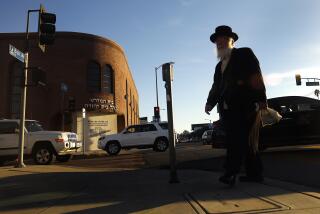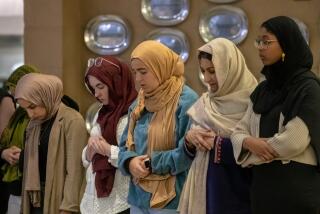A Convergence of 2 Major Observances
Thanks to an unusual overlapping of Western and lunar calendars, Ash Wednesday and Chinese New Year will both be observed today -- the first of two calendar coincidences in 2005. In December, Hanukkah will begin at sundown Christmas Day.
The Chinese New Year is a time of celebration, while Ash Wednesday marks the beginning of Lent, a period of penitence. Cardinal Roger M. Mahony of the Los Angeles Archdiocese issued a statement saying that those who wish to celebrate Chinese New Year today may perform their Ash Wednesday obligation of fasting on Saturday.
“It’s not uncommon for bishops to issue dispensations from church disciplines in situations such as this one,” said Tod Tamberg, spokesman for the archdiocese. “This is really just a question of pastoral sensitivity to the members of the church community for whom this is an important cultural celebration.”
The dispensation is for people living in the archdiocese, which covers Los Angeles, Ventura and Santa Barbara counties. Tamberg said there were more than 1.5 million Asian American Catholics in the archdiocese.
Behind the unusual occurrence are the methods used to calculate the two kinds of calendars.
Though commonly called lunar, the “lunisolar” calendar is based on cycles of the moon and sun and can have 353 to 355 days. In this instance, the lunar new year begins on what the Gregorian calendar calls Feb. 9.
The passage of the moon also relates to the celebration of Easter and explains why the date of that holiday varies. Easter is observed on the first Sunday after the first full moon that occurs on or after the vernal equinox. This year, Easter falls on March 27.
In a December letter to priests in the San Francisco Archdiocese, Auxiliary Bishop Ignatius Wang said the lunar new year celebration “continues for a period of two weeks, and in countries where it is observed, the obligation to fast and abstain is suspended for the days that fall during Lent. Since this festive season is not as widely observed here in San Francisco, one should not expect a general dispensation.”
Wang added that individual requests for a dispensation would be considered on a case-by-case basis.
At 8:30 p.m. today, Father Joseph Hoang of St. Columban Church in Orange County will celebrate the Lenten season and the Chinese New Year with a special Mass to commemorate both. Hoang said that the Chinese New Year was a time of remembrance, celebration and thanksgiving, and that it was possible to mark both.
“It is the opportunity to give thanks to God -- much like Thanksgiving for the American culture,” he said. “It is time to remember the land that we came from and the people that we came from -- and we pray for them.”
The Gregorian and Hebrew calendars will continue the trend of coincidental holidays with Christmas and the beginning of the eight-day Hanukkah observance. “I can’t remember the last time Hanukkah went into January,” said Rabbi Alan Lachtman of Temple Beth David in Temple City. “The greatest thing for us is that Hanukkah spans two years.”
According to the Hebrew calendar, which also is tied to lunar cycles, Hanukkah occurs on the 25th day of the month of Kislev.
The year normally has 12 months. But seven times in a 19-year cycle, an extra month is added to the year. This extra month -- a repeat of the month Adar -- has the same effect as the extra day in a Western leap year, bringing the calendar up to date.
More to Read
Sign up for Essential California
The most important California stories and recommendations in your inbox every morning.
You may occasionally receive promotional content from the Los Angeles Times.










